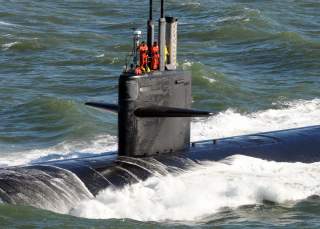Why the Future of the U.S. Navy Could Be 'Robotic Submarines'
One of the first Navy lines of effort aimed at fielding a robotic submarine is the Extra Large UUV or XL-UUV program. HII is teaming with Boeing to bring that project to fruition.
Unmanned underwater vehicles might mean big business for shipbuilders if the technology lives up to its promise. It is too early to gauge the exact size of the future UUV market and the Unmanned Aerial Vehicle (UAV) market may not be a good comparison.
“We’re excited about where that could lead – where that might go for the future. As far as the size of this market, you can – it’s kind of hard to size it,” Mike Petters, president and chief executive officer of Huntington Ingalls Industries (HII) told investors.
“But you could go back and take the UAV marketplace back to 20, 25 years ago. And I’ve seen the curves that say here’s what happened with UAV, it’s kind of flat for a while and then it turned and went up. And I don’t know where we are on the curve around UUVs.”
The undersea environment is very different from the air and the engineering challenges are not the same.
“I was a submarine guy, I can tell you for sure that the thing about being underwater is very different than being in the air,” Petters said.
“It’s a different set of engineering and engineering challenges to solve. I can’t say for sure that the curve is going to go up in the way that the UAV curve did.”
HII is taking up a leading role in the Navy’s quest to field UUVs. One of the first Navy lines of effort aimed at fielding a robotic submarine is the Extra Large UUV or XL-UUV program. HII is teaming with Boeing to bring that project to fruition.
“The Navy’s gone forward with this XL UUV program,” Petters said.
“We’ve actually been teamed with Boeing to participate in that program. And we are very, very excited about the chance to work with the company like Boeing that’s got a long history in this space. And I think they are excited that they have access to some of our technical capability as well.”
Ultimately, HII expects that UUVs will be a mainstay of the Navy’s fleet and the company is positioning itself to be a major player in that market.
“We are taken out of position in the front end of this program,” Petters said.
“It’s been a strategic emphasis for us for the last three years or four years to go figure out how to get in on the front end of this thing. We’re excited about our position now. And when that curve does hit the knee and start to accelerate up, we expect to be a pretty big player in it.”
Dave Majumdar is the defense editor for The National Interest. You can follow him on Twitter: @Davemajumdar.

